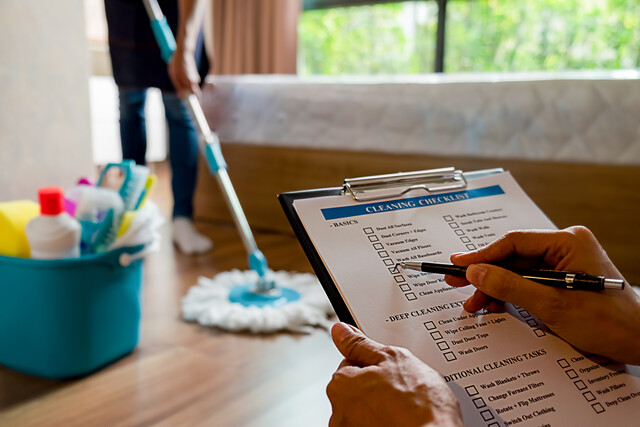Every establishment has a specific protocol for taking orders from the table and giving them to the kitchen and assembly areas. A new server needs to learn this protocol as quickly as possible in order to be an efficient team member. Asking for your order to be a "rush" order is not a good idea, unless there is a really good reason for it. Servers who are always "rush" orders will find themselves placed at the back of the queue, more often than not.
Orders can be written on checks, the duplicate of which is given to the kitchen. If handwriting orders, your handwriting must be legible and easy to understand. Always use the appropriate abbreviations; do not make up your own -- the kitchen will not understand them. Keep your original check or ticket as this is your record of the food that you have ordered from the kitchen, and from which the final bill will be prepared. Never throw these away. If a mistake has been made, run a line through the mistake, and, if necessary, have the manager initial it.
More and more restaurants are using a Point of Service computer where you will enter the order from your table and it is automatically delivered via the computer to the kitchen.
Your biggest job will be the timing of your orders. Make a point of learning how long it takes to prepare any given dish, then put in the order for the one that takes the longest to prepare first. That way, all dinners for a given table should come out at the same time. Nothing is more uncomfortable for your guests than to serve three guests at a table, only to find out that the fourth guest's meal has not yet been started.
The next point that requires your attention is to keep hot foods hot and cold foods cold. Not only is this necessary for food safety, it also helps to preserve the beauty of the prepared food.There is nothing more unappetizing than to have a cold pat of butter melting on the bread and butter plate because it was served hot. It is your job to ensure that the food arrives at the table in the condition in which it was served from the kitchen.
As a server, this is your job.
Approaching the Table:
Usually the table is already setup and ready before you approach the guests--they should be seated and ready to greet you. The rule to follow when approaching your guests is to pleasantly greet them at table within one minute of them being seated. First impressions are exactly that. You never get a second chance at a first impression. Make sure that yours is pleasant, welcoming, helpful, and neat. Smile, make eye contact, and give them your name. Water should be brought to the table at this time, whether by you, the busser, or the hostess. Teamwork will make your first impression a good one.
All parts of the process must be present in order to make a good impression. It is never enough to give your table fast and efficient service if you do so without a smile and a pleasant demeanor. Your customer needs to feel important and that their patronage is appreciated.
Whether you know it or not, you are in the business of selling a product; you are the salesperson, and how you approach your customer will determine the price of the final product. Restaurants sell food, service, atmosphere, and entertainment. If your customers feel they are unimportant in your eyes, they will find an establishment that does appreciate their presence and patronage. Most of the time, you will never know when you have permanently lost a customer; they will quietly leave, and never return. They will also tell their friends and family about their experience, and business for your establishment can drop off.
Understanding your position as a sales person, as well as being a server, is vital to your success and the success of your restaurant. Behave accordingly.
Drink Orders:
The first order to fill is the drink order. In today's increasingly aware environment regarding the economy, water is not always served in every restaurant. Be sure to ask your guests if they would like water, because many of them still do not realize that serving water is no longer the norm.
After checking about water needs, share the soft drink and beer menu with your guests, as well as any varieties of ice tea that you offer. This order needs to be taken and served very quickly. Once the drinks are served, you may ask if your guests are ready to order. Your clue will be that all your guests will have closed their menus, or placed them back on the table.
When serving drinks, handle the glasses by the bottom. Never put your finger near the lip of the glass, where your customer will be putting his or her lips. As many times as you may wash your hands, you can still pick up bacteria that can be harmful to your guests, so always handle glassware by stems, handles, or the bottom of the container.
Often there will be one guest who is still perusing the menu when you approach the table to take the order. This is a good time to ask if there are any questions about the menu. Be helpful. If you have new guests who have never been to your establishment before, be knowledgeable about the menu, where specific items are, and offer to help your guest to find such items. Answer any questions about the menu; give your guest a list of the items included in a dish, if they ask, and be familiar with how each menu item is prepared.
Taking the Food Order:
Proper etiquette requires that you start with the women of the table, then the children, and finally move on to the men. If, however, the woman is undecided, it is absolutely fine to move on to the next guest so that you do not make her feel uncomfortable.
In taking the order, have your list of questions memorized. If ordering a salad, what kind of dressing? If ordering baked potato, what garnish? If ordering steak, how does it need to be cooked?
By creating a list of questions for every menu item, you will be prepared when you are taking the order, and will not have to return to the table when the kitchen asks you for the missing detail, because you forgot to ask. It makes for better and much more efficient service, if you ask all your questions while you are taking the initial order.
If a customer is unsure, make a suggestion or two and what is particularly appealing about those dishes. This is where you can shine as a salesperson.
Delivering the Food;
If your establishment does not have a set rule for how to serve plates of food, then serve and remove dishes from the patron's right-hand side. Keep your fingers out of the food, and handle the dishes by the edges only. Bring all food for the table out at the same time. Never leave a guest without food. If the plates are hot, be sure to warn your customers not to burn themselves.
Checking Back:
If there is a problem with the meal, it will be discovered within the first few minutes of eating. Check back with your guests to ensure that they are satisfied with their meal. If there has been a mistake and you delay your return to the table, your customer will merely sit and fume, with your tip diminishing rapidly.
Dessert:
After the dinner entrée plates have been cleared from the table, you present the opportunity to order dessert and coffee, or after-dinner drinks. Dessert menus are presented at this time, or a dessert tray is brought to the table. Be sure to offer to split a dessert in case your guests are feeling full. Again, you are in sales, and by making such an offer, you might sell one or two desserts, rather than none. If you have a particularly popular after-dinner drink, mention that as well, especially if your guests show signs of wishing to linger.
The check should be presented either with the last course, or just as the last course is being completed. Your guests should never have to look around the restaurant to catch your eye to let you know they wish to pay. Ensure the accuracy of the check and lay it face down to the right of the host's cover, on a small tray, or in a check folder. If you are unable to determine who the host may be, place the check near the center of the table. If two people are dining, it is appropriate to place the check between the two guests.
It is always wise to ask prior to totaling the check if there is anything else they wish to order. When you are sure the table is complete, place the check and be sure to thank them for their patronage. When you pick up the payment, and the payment is in cash, be sure to mention that you will bring their change back to the table for the denomination of the bill that is presented. When a credit card is used, give clear instructions as to which copy is yours and which copy they are to keep. Usually this is clearly marked, but it is a sign of a good server to make this point clear.
Your reaction to the amount of the tip must be kept to yourself. Gratuity is exactly that. While there is a certain expectation that at least 15 percent of the bill should be paid to you, not all countries follow this custom, and you may very well have a table full of Europeans who are accustomed to having the gratuity included in the price of their meals.
Continue to be courteous as your guests are leaving. You have just spent over an hour in their company; say goodbye, help your female guests with their chairs or any packages they may have placed on the floor. It is good customer service to invite your guests to return at some point to see you.
Carrying Trays:
One of your jobs as a server is to be a salesperson. You are in the business of selling food and service, and the more you sell, the higher the check at the end of the night. This means more money for your restaurant. When your guests tip appropriately, it also means more money in your pocket by the end of the night, as well.
One common practice is for an establishment to have a nightly special that may or may not show up on the menu. This is the server's opportunity to present alternate suggestions by listing the evening's specials and what makes them unusual. A server who has learned the specials and is able to present them to the table well, is effectively marketing for the restaurant.
Any foreign names must be pronounced properly, and it is your job, as the server, to learn that pronunciation. Some establishments will have a tasting prior to the opening of the doors for the evening so the servers can see, smell, and taste what the offerings are, and they can honestly tell their patrons that they really enjoy the dish.
You will also be asked by someone who is new to your restaurant what you like the best. While your tastes may not be the same as your customer's taste, it is appropriate to mention two or three menu items that you do enjoy and you can even say why you like them. Knowing in advance that you will likely be asked such questions, you will be prepared to answer them with poise and self-assurance. No one wants a server who has never tasted anything on the menu. If you will not eat it, why should they pay to eat it?
Again, know your menu. Know everything on it, know what is in each dish, and know how each dish is prepared and served.
Making Suggestions to the Customer:
You will often encounter a customer who has either never been to your establishment, or really is unsure of what they would like to eat that day. Your job, as the server, is make it easier for them to make such a choice.
You will need to determine if they are looking for a "lighter" meal, in which case you can suggest a soup, or salad and sandwich. Perhaps your customer will ask about a dish and what makes it special. By knowing exactly how it is prepared, and perhaps something specific about it that makes it unusual, you will often intrigue your guests and they will order based on your suggestion. For a dinner guest who simply cannot make up his or her mind, select two or three of your most often-ordered entrées and suggest those. Typically, narrowing the choice down from an entire menu selection to only two or three is enough to simplify the process for your guests.
As for making a suggestion about other parts of the meal, always try to suggest a salad or vegetable plate for added nutritional value. When your table has had a very heavy meal and asks for a suggestion for dessert, it makes more sense to suggest a lighter dessert, rather than your 65-layer chocolate cake.
By combining tact with good salesmanship, you will be able to help your guest feel you are being helpful, rather than pushy and trying to pad the bill for your own benefit. It never pays off to always suggest the most expensive item on the menu. We will discuss more about this later.
You can also influence your guest who has simply ordered water to drink, by taking their lunch order and then asking whether they would like milk, tea, or soda to drink. This way you will offer your guest an additional choice, and they will frequently take you up on the offer.
When your table orders something that will take some time to prepare, it is very appropriate to offer an appetizer or soup, so that they are not left waiting for a long time before their food is ready. In this way, you have made the offer, and they have accepted it and ordered additional food, something they likely will not have done on their own. By making suggestions, you are ensuring your guests are comfortable and are having all their needs met.
Substitutions:
Each establishment has its own policy about substitutions. Know the policies of your restaurant prior to promising something to your customer. If you do not know, find out prior to making the promise. Your customer will only feel uncomfortable and upset if you agree to make a substitution, then find out that it is impossible to make.
Purpose of Suggestive Selling:
As you work in a restaurant you will discover that you have some customers who know exactly what they want to eat, and despite every attempt you make, they will order only what they want and will not be persuaded to order anything else. That is fine. This customer is actually very easy to please.
The customer who is unsure is a little more difficult. By discovering why your customer is uncertain about what they wish to order, you can then make appropriate suggestions.
Some customers are unfamiliar with your restaurant, and your menu offerings. In this case, you ask for questions and answer them as knowledgeably as you possibly can. Some people are not very hungry, but have joined the group to be sociable. In this case, it is appropriate to suggest soup, salad, or an appetizer, rather than ordering an entire meal. Your guest will appreciate your tact, and will be satisfied that their hands will be busy while everyone else is eating.
Perhaps your customer is on a limited budget and your menu offerings are on the pricey side. You can ask what looks good to them, and if your establishment makes this an option, you can serve items a la carte, or in a smaller portion, to allow for their budgetary needs. You might even have a nicely priced special that is not on the menu that will meet their needs. By exercising some curiosity, as well as some tact, you will usually be able to make suggestions that make your customers feel special and important, rather than inadequate and unwelcome.
Should your customer be ordering from the a la carte menu, you can still sell additional food by asking if they would like a beverage with the sandwich, or if they would like a sandwich with the soup.
Asking specifically if the guest would like something is more likely to elicit an additional order, rather than asking a more general question like, "Would you like anything else?" This usually meets with a negative reply and the business transaction is concluding. The longer you keep the transaction open, the more food you will sell.
In fine dining restaurants, one of the reasons you are to arrive ahead of your shift is so you can memorize the specials list, their ingredients, preparation methods, and sometimes have a tasting of the food so you can sell it authoritatively.
Customers like products that are made from local produce or from seasonal items. If you have a special that is similar to a regular menu item, but it is a better price, be sure to draw that to your guest's attention. Many times they will order the special because it is on sale.
Specials can also be something the chef is trying out and has never made before. It can be something that is being "test-marketed" before making it available on the regular menu. Such a special has a way of making the guests who try it feel as though they are having some input on the menu of their favorite restaurant.
Higher-priced items can be a touchy subject. It is never good form to always suggest the highest-priced items when your guest is uncertain. What you might be able to do, instead, is ask what looks good to the guest, and then make an alternate suggestion for a higher-priced item that is similar, but may be made with items of better nutritional value, or with locally grown produce, or with items that are seasonal only. Your guest will then feel more that you were instrumental in helping to decide on a better meal, rather than feeling strong-armed into a higher-priced plate just to pad the bill.
Value-added service:
- Make recommendations based on your intuition. Look for clues as to why they are dining with you. Make celebratory suggestions, if appropriate, or appetizing lower-priced suggestions if they appear to be on a budget.
- When guests become regulars, remember their name, and try to remember some of their likes and dislikes. According to Dale Carnegie, a person's name is the most important sound to them. Using it will be very powerful.
- Give extra service that is not exactly in your job description. Offer to package something in a special way if you can. On the night my husband proposed to me, my leftovers were wrapped in foil in the shape of a beautiful swan. I never forgot that, and have told literally hundreds of people about it.
- Make a guest feel good about a choice made, whether an entrée or a wine that they have selected.
- Talk to your single diners. Often they are business people traveling alone and are on an expense account. Taking time with them can often be rewarding.
- Anticipate needs and keep drinks filled.
- Be aware that older guests have different needs. Anticipate them, and be ready to answer any questions they may have about the menu, and what other offerings you have.
- Do NOT focus on the tip. If you do your job right, your average tip will reflect this.
- Share any success with the chefs. They usually only hear about the mistakes.
























